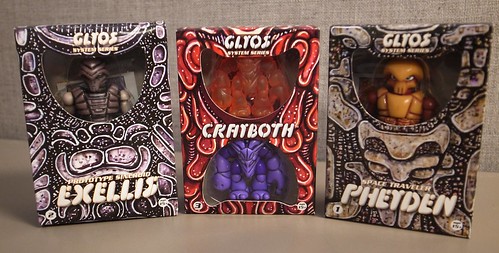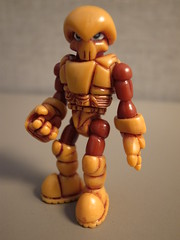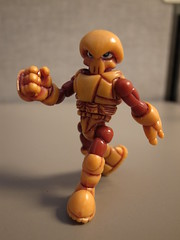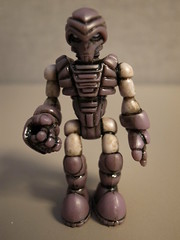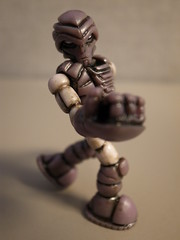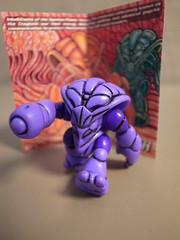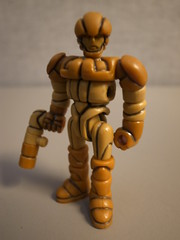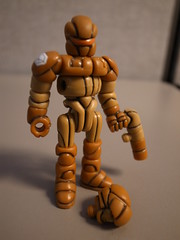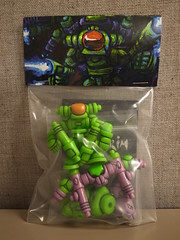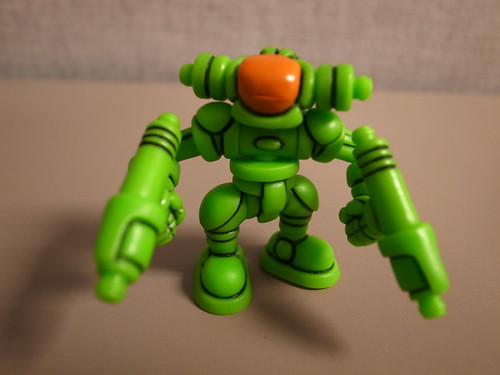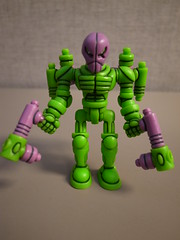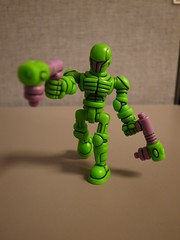I mentioned recently that I tend not to review much modern stuff that influenced by the 80s era stuff that I loved growing up. Part of this is because of how I feel about the current 80s regurgitation, but another part is more about spending. I just don’t buy all that many toys or doodads because the wife and I have no idea where to put this stuff. We have a bunch of stuff as it is and we hesitate to keep adding to the pile for fear that we’ll become buried in some sort of cool-stuff avalanche. So when we do pick something up we try to be pretty judicious about what we buy. Following this train of thought I’ve been limiting a lot of my toy purchases to stuff that is small, literally. Blind pack Lego minifigs, minimates, the various tiny “Heroes” figures from Hasbro, Hotwheels, etc. It’s more about display than playability at my age anyway, so why not try to condense the size of a collection with 1.5″ figures instead of the more normal 3.75″-8″ lines.
Then there is the world of independent and small run toys, stuff like vinyl figures from outlets like Kid Robot and a million other indie molders, casters, and painters that work with everything from resin and vinyl to word and PVC. There’s all sorts of awesome stuff out there, but I’ve kept myself pretty sheltered from it because they’re typically some pretty darn expensive art toys. I mean if I’m grumbling in the toy aisles of my local Target because G.I. Joe figures are at the crazy inflated price of almost $10 a figure, then you know I won’t be jumping at the chance to pick up independent toys at $40-$100 apiece (not that I don’t want to.) I’m not saying that there aren’t any cheaper options for these sorts of art toys, I’ve just been hit with sticker-shock so often that I tend to filter them out.
Well, that changed recently after Phillip Reed over at Battlegrip.com spent an entire week looking at a particular independent toy-line. It’s called the Glyos System and is produced by a group called Onell Design. I’m not 100% versed in the fiction, but the general idea is that these are a set of futuristic humanoids and robots in space. The figures range in size from 1.5″ to around 3″ tall and are all comprised of modular pieces of hand painted PVC. So this system is combining the concept of the action figure with that of a building block set like Lego bricks, that encourages customization…
What really grabbed me at first was the overall design aesthetic of the toys, in particular the color schemes and the odd juxtaposition of simplicity and complex design. I also loved the design of the various character head sculpts, especially on this little orange guy they call Pheyden (specifically this one is known as the Gears Edge Pheyden.) The dome shape to the helmet with the skull accents is really cool…
I think this design aesthetic is so powerful because it has been expertly culled from all sorts of existing pop culture while retaining a simplicity that completely separates itself from its many influences. When I look at these figures I can see aspects of films, videogames and cartoons like Robocop, Tron, Alien & Aliens, Metroid, Megaman, Section Z, Robotech (in particular the series three Invid Invasion episodes), Inhumanoids, and the Centurians just to name a few. At the same time, there isn’t enough of any one of these homages that the Glyos System still feels completely like its own unique design. That’s a really tough thing to accomplish.
There’s also a lot of aspects to these figures that I really dig that are playing off of some of the more modern toy designs like the chibi, or super deformed body design; large hands and feet with slightly disproportionate leg and arm lengths. Also, I find it very interesting to see this sort of modularity in an action figure line. Sure, there were a bunch of original Star Wars and He-Man figures that you could pop the heads and arms off of and switch around, but not really since the Micronauts have we seen this sort of concept. For awhile in the early to mid 2000s there were those Stikfa figures, but their modularity was more about articulation than customization. I’m sure there are some action figure lines I’m forgetting, but I still think this is a rare concept for the genre.
Though this might be a little greedy and crass, I have to say that what ultimately won me over to buying a bunch of these figures is the really low price point. There are a handful of older legacy figures in the Onell Design shop that are as low as $4 a piece. Considering that these are hand cast, assembled and painted, that’s a steal. Even the newer figures range from $6-$10, which is still more than reasonable when compared to other independent toys.
What’s also really cool is that this system has infected the indie toy market to such an extent that there are a lot of other people making attachments and figures that are completely interchangeable with the originals. Onell Design has a sister site called Callgrim that has their own variations on the system that add a whole new level to the collection. I also love that there are some standard “characters” too; Onell has a couple of main characters, Pheyden and Exellis, Callgrim has their own, The Order (seen below as a standard figure with the robotic blank faceplate) and Callgrim (which has the more hockey mask/skull influenced faceplate.)
Callgrim has also taken the modularity to a whole new level by sculpting some of the pieces to be really multi-purpose. he set I picked up is based around the character called the Warp Dome Terra Mite…
…that figure’s head can be positioned in two ways, one like above that makes it come off as an android sort of robot, or if you twist it around it becomes a variation on the Callgrim faceplate, only a bit more alien. These head pieces also double for a very cool-looking base piece for a backpack or jet pack…
All in all, though I’m still really new to these toys, I’m becoming addicted to them. I missed out on the last rollout of figures, but I’m keeping my eyes peeled on the Onell Design and Callgrim blogs for any information on new stuff. I feel like I’m 8 years-old again!

